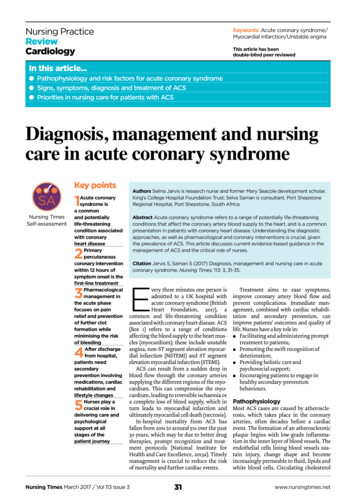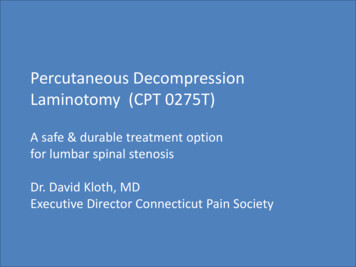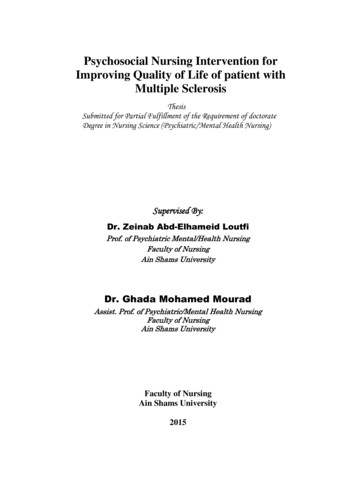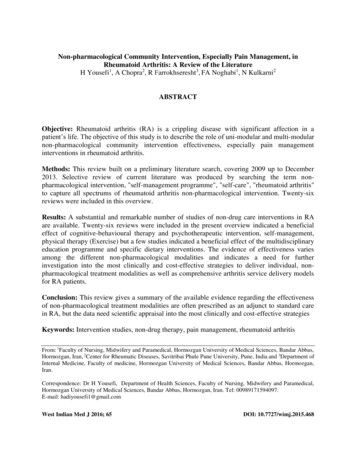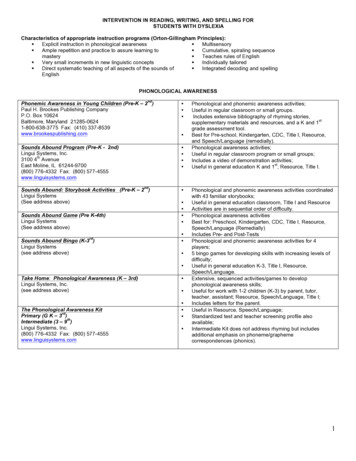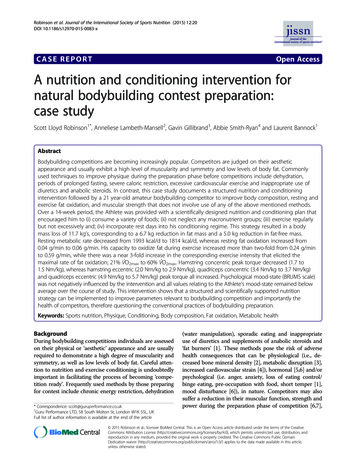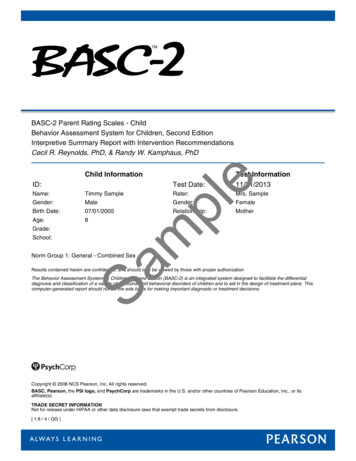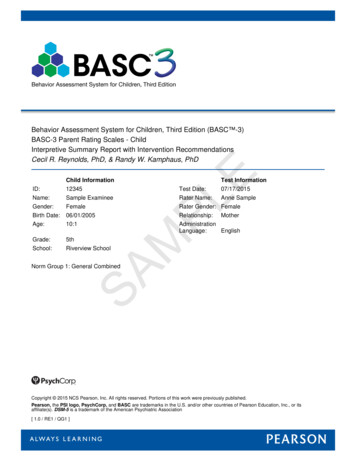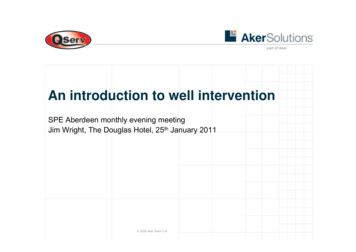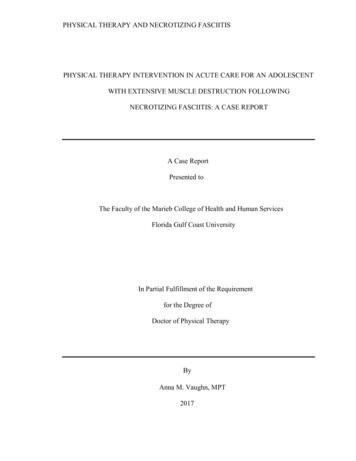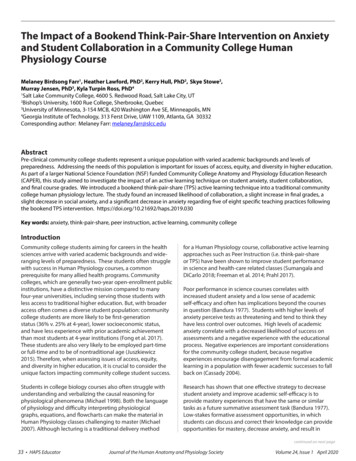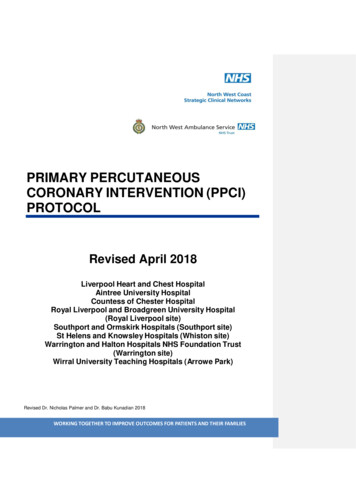
Transcription
PRIMARY PERCUTANEOUSCORONARY INTERVENTION (PPCI)PROTOCOLRevised April 2018Liverpool Heart and Chest HospitalAintree University HospitalCountess of Chester HospitalRoyal Liverpool and Broadgreen University Hospital(Royal Liverpool site)Southport and Ormskirk Hospitals (Southport site)St Helens and Knowsley Hospitals (Whiston site)Warrington and Halton Hospitals NHS Foundation Trust(Warrington site)Wirral University Teaching Hospitals (Arrowe Park)Revised Dr. Nicholas Palmer and Dr. Babu Kunadian 2018WORKING TOGETHER TO IMPROVE OUTCOMES FOR PATIENTS AND THEIR FAMILIES
CONTENTS PAGEPage No1.Introduction32.Clinical Criteria for patients presenting via 99943. Clinical Criteria for patients presenting via local hospital44.Patient Assessment55. In-Hospital Assessment66. Patient preference67. Consent to transfer68. Arranging ambulance transfer from local hospital to LHCH79. Patient/family information710. Primary PCI Pathway for patients who dial 999811. Primary PCI Pathway for patients who present via their local Hospital912. Algorithm for antiplatelet in PPCI1013. Handover1114. In-patient stay1115. Discharge process1116. Follow-up1117. Cardiac Rehabilitation1218. Emergency Planning1219. Appendix One NWAS Primary PCI Patient Assessment Checklist1320. Appendix Two Primary PCI Information Sheet for Next of Kin1421. Appendix Three NWAS Control Centre Pathway1522. Appendix Four Primary PCI Transfer Checklist162
1.INTRODUCTIONThe Primary Percutaneous Coronary Intervention (PPCI) service is available for all eligible patients atLiverpool Heart and Chest Hospital (LHCH - formerly the Cardiothoracic Centre on the Broadgreensite) 24 hours per day, 7 days a week (24/7). This protocol has been further updated to includeguidance on patient management in local partner hospitals in circumstances where there issignificant delay to the ambulance transfer to LHCHAll patients, with ST Segment Elevation Myocardial Infarction (STEMI) fulfilling the clinical inclusioncriteria within the Cheshire and Merseyside Network catchment area, may be offered this treatment.The catchment area is defined, as that of those patients with STEMI who would normally attend or betaken via ambulance to the following hospitals:Aintree University Hospitals NHS Foundation TrustCountess of Chester Hospital NHS Foundation TrustRoyal Liverpool & Broadgreen University Hospital NHS Trust (Royal Liverpool site)Southport & Ormskirk Hospitals NHS Trust (Southport site)St Helens & Knowsley Hospitals NHS Trust (Whiston site)Warrington and Halton Hospitals NHS Foundation Trust (Warrington site)Wirral University Teaching Hospitals NHS Foundation Trust (Arrowe Park)This protocol illustrates the steps required to identify those patients who would benefit from receivingthis intervention, the operational steps required for accessing the PPCI service at LHCH and themanagement of the patients’ discharge home, which includes follow-up and rehabilitation.It details the clinical inclusion criteria and the pathways for:AThose patients who dial 999 and will be clinically triaged by ambulance paramedics.Suitable patients will be taken directly to the catheter lab at LHCH.BSelf-presenting or in-patients who may be referred for PPCI from their local hospital.This pathway also includes those patients who have been taken to their local hospitalvia ambulance for further assessment. All of these patients will require emergencytransfer to LHCH.3
2.CLINICAL CRITERIA FOR PATIENTS PRESENTING VIA 999For those patients who dial 999 and will be clinically triaged by ambulance paramedics. Suitablepatients will be taken directly to the catheter lab at LHCH.Ambulance inclusion criteriaAlert and able to give verbal consent to transfer to LHCHSymptoms compatible with an acute MI (eg chest discomfort,breathlessness, collapse) AND with the following ECG criteria:ST segment elevation 1mm in contiguous (adjacent) leads other than leadsV2 &V3(For leads V2 &V3, ST elevations must be 2mm in men and 1.5mm in women)Or deep ST depression in Leads V1- V3 (suggesting posterior MI)Patients resuscitated from cardiac arrest not requiring intubation/ventilation,with ECG criteria as aboveAmbulance exclusion criteriaEvidence of significant, active bleedingPaced rhythm on ECG or LBBBCardiac arrest on-scene resulting in patient being intubated or unconscious(however, patients who are successfully resuscitated and able to give verbalconsent can still be transferred directly to LHCH)3.CLINICAL CRITERIA FOR PATIENTS PRESENTING VIA LOCALHOSPITALFor self-presenting or in-patients who may be referred for PPCI from their local hospital. This pathwayalso includes those patients who, have been taken to their local hospital via ambulance for furtherassessment. All of these patients will require emergency transfer to LHCH.Inclusion criteriaAlert and able to give verbal consent to transfer to LHCHSymptoms compatible with an acute MI (eg chest discomfort,breathlessness, collapse) AND with the following ECG criteria:ST segment elevation 1mm in contiguous (adjacent) leads other than leadsV2 &V3(For leads V2 &V3, ST elevations must be 2mm in men and 1.5mm in women Ordeep ST depression in Leads V1- V3 (suggesting posterior MI)Patients resuscitated from cardiac arrest not requiring intubation/ventilationwith ECG criteria as aboveDiscussionThe inclusion criteria are evidence based to maximise patient benefit but in exceptionalcircumstances, where the senior on-site clinician considers a patient does not meet thestandard inclusion criteria, but would still benefit from PPCI, they should discuss the casewith the on-call interventionist at LHCH, via a direct mobile number, 07769 135 8834
4PATIENT ASSESSMENT4.1AMBULANCE ASSESSMENT1Upon arrival at scene, the paramedic will establish the history of the incident or mechanism ofinjury whilst ensuring ABCs.2If the patient’s symptoms suggest an acute MI, the patient will be placed on highconcentration oxygen, via a mask and reservoir, if indicated (SpO2 94%) and titrated tomaintain SpO2 94%, as per current NWAS Pre hospital chest pain policy. The patient willalso receive 300 mg of aspirin and GTN and will be transferred to the ambulance at theearliest opportunity.3Once on board the ambulance the paramedic should acquire a 12 lead ECG and determine ifa STEMI is evident (refer to the inclusion criteria page 4).4If no STEMI is evident, the patient must be transported to their nearest hospital immediately,providing appropriate treatment en-route and provide an Amber pre-alert notification via theEmergency Operations Control (EOC) using Age, Sex, History, Injuries, Condition, Estimatedtime of arrival to the hospital (ASHICE)5If a STEMI is evident and if PPCI is available at the present time, then the paramedic mustproceed to complete the PPCI assessment checklist (appendix one) to establish if the patientmeets the inclusion criteria.6If the patient does not meet the inclusion criteria then they must be transported to their nearesthospital immediately for further assessment and provide a Red pre-alert notification via theEOC using ASHICE7If the patient fully meets the inclusion criteria and has given consent in principle to beingtransported to LHCH for the procedure then the paramedic must inform control that a patientrequiring ‘Primary PCI’ is being transported to LHCH, providing a Red pre-alert notificationusing ASHICE via EOC *8The patient’s next of kin, or accompanying adult, must be given the tear off information sheet,which is on the PPCI checklist (appendix two).9The patient must then be transported to LHCH immediately, using visual and auditory warningdevices.10 Attempt at cannulation, in the left arm, definitely avoiding the right hand, should be madewhilst en-route and when it is safe to do so.11 Whilst en-route to LHCH, the paramedic must complete observations and administer painrelief.12 On arrival at the LHCH, the patient must be continually monitored using the Lifepak 12/15 untilhandover in the catheter lab*(The ambulance control operator will follow the pathway illustrated in appendix three to inform LHCH of thepatient’s imminent arrival. This telephone call will firstly inform LHCH that the patient is en-route and secondly itwill be the first step in activating the internal protocols within LHCH that will ensure the PPCI team and thecatheter lab are ready for the patient. This will include ‘calling in’ the PPCI team if out of hours. In the event thatthe ambulance has to be diverted to an alternative location (usually a local A&E department) then it is theresponsibility of the control operator to ’stand down’ staff at LHCH using the telephone number 0151 600 1817)5
5.IN-HOSPITAL ASSESSMENTSTEMI patients presenting at, or who are already in-patients at any of the local hospitals detailed onpage three will have access to the 24/7 PPCI based at LHCH. In addition, patients who have not fullymet the ambulance inclusion criteria and have subsequently been taken to their local hospital maythen be considered as suitable candidates following further clinical assessment and/or discussion oftheir individual case with a specialist clinician at LHCH. If the referring hospital identifies the need todiscuss the clinical or ECG evidence with the on-call cardiology consultant at LHCH then this, will becarried out with a minimum of delay. Once the patient has been assessed as being a suitablecandidate to receive PPCI they will then be rapidly transferred to LHCH via ambulance. On arrival atLHCH, ALL patients will be clinically assessed for suitability, to proceed to PPCI, including referralsalready accepted. On occasion, PPCI may not be the best treatment strategy and the “On Call”Interventional Cardiologist will determine this.6.PATIENT PREFERENCEWhen a patient is considered suitable for PPCI, the final determination in the selection of thistreatment strategy must always be that of patient preference. In obtaining the agreement to transfer, itis important that the patient understands the benefits and risks associated with the treatment they arelikely to be offered at LHCH. This agreement must be sought before transfer to LHCH.6.1AMBULANCE CREWSIf a patient meets the clinical inclusion criteria but does not consent to transfer to LHCH, the patientshould be transported to their nearest hospital immediately for further assessment/treatment.7.CONSENT TO TRANSFERThe following does not have to be read verbatim but these are the key facts, which should be relayedto the patient prior to transfer to LHCH. *Heart AttackWe believe that you are having a heart attack. A heart attack is caused by a clot, forming in one of theheart’s blood vessels. The area of heart muscle that this blood vessel supplies is then starved ofoxygen and nutrients. The aim of treatment is to re-open this blocked vessel in order to restore bloodflow and so minimise the damage done to the heart.TreatmentThe best treatment to open up your blocked heart artery is called an angioplasty. This involvespassing a small tube in to your wrist or groin and then a catheter up to your heart. A small balloon isthen passed in to the blocked artery and inflated, and this will restore blood flow to the heart. Theangioplasty procedure does have some risks associated with it but the benefits far outweigh therelatively small risk of complications.LocationThe procedure can only be performed at The Liverpool Heart and Chest Hospital (formerly called TheCardiothoracic Centre at the Broadgreen site) as this is your local specialist centre. The staff there willdiscuss all of these issues with you in more detail.Do you agree to be taken to The Liverpool Heart and Chest Hospital for assessment?* If the patient is unable to give consent, and the family are not available, the decision to transfer,should be undertaken by two Senior Doctors, acting in the patient’s best interest6
8.ARRANGING AMBULANCE TRANSFER FROM LOCAL HOSPITAL TOLHCH8.1AMBULANCE CREWSThe local hospital clinician must arrange an emergency ambulance transfer to LHCH by telephoningthe control centre on 03451400144. The clinician must ensure they ask for ‘EmergencyTransfer to Liverpool Heart and Chest Hospital for Primary PCI’ It is imperative that this exactterminology is used when requesting an ambulance transfer, as all the control centre staff have beentrained using only this terminology.8.2INFORMING LHCHThe local hospital clinician must ensure that a ‘Hospital PPCI Transfer Checklist’ (appendix four) iscompleted and placed within the patient’s notes, ready for transferring with the patient to LHCH.Prior to leaving the hospital, the paramedic must contact Emergency Operation Control (EOC) toprovide a Red pre-alert notification and ETA.The EOC Operator will immediately confirm the information and activate the LHCH Primary PCI’policy by telephoning the dedicated number 0151 600 1817This process will ensure LHCH is informed of the patient’s imminent arrival, thus activating theinternal protocols that will ensure the PPCI team and the catheter lab are ready to receive the patient.This will include ‘calling in’ the PPCI team if out of hours.8.3 AMBULANCE DELAYS – CONSIDERATION OF THROMBOLYSISIt is recognised that there are on occasions delays to the prompt arrival of the transfer ambulance atthe local hospital. If it is anticipated that there will be a significant delay to transfer which could result inthe patient breaching the 120min call to balloon time window consideration should be given tothrombolysis in the local AED. Advice and guidance can be sought from the LHCH Cardiology SpR orConsultant on-call. Upon arrival of the ambulance the patient can still be transferred if persistent STelevation.9.PATIENT/FAMILY INFORMATIONIt is important that the patient themselves and their family/carer/next of kin are kept fully informed oftheir condition, the treatment options available to them and the risks and benefits associated withthose treatment options. Once consent to transfer to LHCH has be
Appendix Four Primary PCI Transfer Checklist 16 C. 3 1. INTRODUCTION The Primary Percutaneous Coronary Intervention (PPCI) service is available for all eligible patients at Liverpool Heart and Chest Hospital (LHCH - formerly the Cardiothoracic Centre on the Broadgreen site) 24 hours per day, 7 days a week (24/7). This protocol has been further updated to include guidance on patient management .
